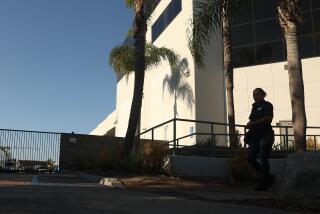Office Buildings’ Ventilation System Not to Be Sneezed At
- Share via
A big ugly bug that “looked like a black widow with wings” prompted Tom Dean to look into the air vents at an office building he was managing in Long Beach a few years ago after the creature landed atop a client’s hair, sat briefly, then buzzed back into the air duct from whence it had come.
What Dean found were cruddy ducts and vents that provided a pleasant habitat for ugly bugs but needed a thorough cleaning to render them suitable for carrying air to humans.
To the surprise of Dean, now a vice president with Beverly Hills-based Arden Realty, cleaning the ducts did more than debug them. It reduced heating and air conditioning operating costs by about 15%.
Dean’s tale of the ugly bug is one of the most colorful illustrations of what landlords have discovered in recent years as they’ve looked into their air conditioning and ventilating systems.
They’ve discovered, according to indoor air consultant Wayne Hansen of Los Angeles-based Mintie Corp., that keeping the ventilating systems clean not only reduces their operating costs but cuts down on complaints from building workers about coughing, sneezing, wheezing, runny noses and other annoyances associated with poor indoor air quality.
And those complaints, according to Hansen, are not to be sneezed at. He said a typical workers’ compensation claim blamed on bad building air costs a national average of $27,850--including $21,000 for medical treatment, $4,750 for insurance premium increases and $2,100 for an employer’s cost of processing the claim.
L.A.’s often-poor-quality air outside causes relatively few problems inside office buildings, according to Hansen. He said ozone, for example, is a highly unstable gas that tends to break down into oxygen as it is “bumped around” by the building’s ventilation system.
Other pollutants tend to be filtered out by the ventilating system too, he said. “What’s going on with the outside air is generally less important in Los Angeles than what’s being generated inside the building,” Hansen said. Inside sources can include vapors from chemicals used by office equipment or processes such as animation, glues and other chemical compounds used for installing carpet or in other interior remodeling jobs, fingernail polish remover, hair sprays, perfumes and after-shaves.
The prospect of reducing operating expenses and preventing worker complaints has prompted at least one landlord, Arden, to embark on a systematic program to check out all of the ventilation systems at all of its buildings, said Randy Noblitt, an Arden senior vice president.
“As buildings age, a lot of insulation and other things can come loose and restrict the air flow. If the system is clogged, it has to work harder to circulate the air, which increases energy costs,” Noblitt said. “We’re trying to make sure our buildings work at peak efficiency.”
Arden launched its HVAC improvement program about a year ago, in part because the company had acquired many properties from previous owners and wanted to be sure all of the properties’ ventilating systems were up to snuff. The program includes tenant surveys to identify indoor air quality concerns, he said.
More than anything, Hansen said, Arden’s program underscores the change in thinking about indoor air quality since phrases like “sick-building syndrome” and “building-related illness” began creeping into the language about a dozen years ago.
Many landlords originally thought the worker complaints were unfounded or, if found to be genuine, that they would result in a slew of lawsuits contending serious health problems.
Some such suits did materialize. In a multimillion-dollar civil suit that may have been the first of its kind, workers at Airport Towers in El Segundo contended they suffered a host of health problems shortly after they moved into a new high-rise in 1985. The case was settled out of court in 1990.
More recently, similar suits claiming millions in damages have been filed in Florida, Illinois and Pennsylvania. But for the most part, the expected legal onslaught hasn’t arrived, especially not in Southern California.
“I’ve been waiting for the wave of indoor air quality cases for some years, but we just haven’t seen it,” said Roger Holt, an environmental attorney with Ervin, Cohen & Jessup in Beverly Hills. Ditto, said Robert Infelise, San Francisco-based partner in charge of the environmental law practice at Cox, Castle & Nicholson.
Hansen and other sources suggest that what was once thought of as sick building syndrome might more accurately be described as annoying building syndrome or irritating building syndrome.
“Ninety-nine percent of indoor air quality complaints are not health issues; they are comfort issues,” said Hansen, an engineer who designed building ventilating systems for 25 years and has worked as an indoor air consultant for the last 12 years.
Dr. Lee Leer of Eureka, a medical consultant in several indoor air quality cases, agrees with Hansen’s assessment but adds that “health issue” can be a subjective term.
“The question becomes one of semantics. To the extent that a complaint is enough to drive a person to go to the doctor, it is a medical issue,” Leer said, “but these complaints are not serious medical problems. They are not life-threatening.”
Nonetheless, Leer and Hansen both say worker complaints should be taken seriously because they are often well founded, even if they are only “comfort” issues.
“It doesn’t matter to the employee or the employer whether it’s a health risk or a comfort issue because those workers are losing time going to the doctor trying to figure out what’s wrong, or else, if they are at work, they’re less productive,” Hansen said.
Common molds are one of the biggest culprits, according to indoor air experts. Today’s tightly sealed office buildings can increase concentrations of these molds, which are found everywhere, inside and outdoors. Such problems are most prevalent in office buildings, Hansen said, noting that “the average home is sealed about as tightly as a sieve.”
“Years ago, buildings were designed so that when the weather was nice, you opened the [windows] and brought in 100% outside air, so you had constant flushing out of the air,” Hansen said.
Energy conservation standards have since limited the amount of outside air to about 15% of a building’s capacity, and with such little dilution from the outside air, whatever enters a room tends to stay in a room, Hansen added.
That includes colognes, hair sprays and other vapors that don’t bother some people but can induce sneezing, coughing or nosebleeds in others. Hansen said Mintie is often called in to isolate the cause of such problems, which can sometimes be eliminated by persuading someone to switch perfume or just wear less of it.
One of the biggest hurdles in isolating indoor air quality problems, Hansen said, is that they generally can’t be seen. For instance, a minor crack in a plumbing line, while invisible, could allow sewer gas to escape.
The example comes to mind, he said, because of last month’s earthquake near Twentynine Palms. Quakes have been known to crack plumbing lines just enough to allow sewer gas to escape. The smell isn’t life-threatening, but it is a comfort issue.
Hansen said it’s pretty unusual to find insects in ductwork, except for ventilating systems that have been neglected for a long time. However, he said he’s seen a host of insects and animals in building vents over the years.
“I’ve looked into ducts and seen eyes looking back at me,” he said.
More to Read
Inside the business of entertainment
The Wide Shot brings you news, analysis and insights on everything from streaming wars to production — and what it all means for the future.
You may occasionally receive promotional content from the Los Angeles Times.










